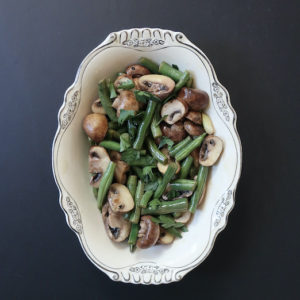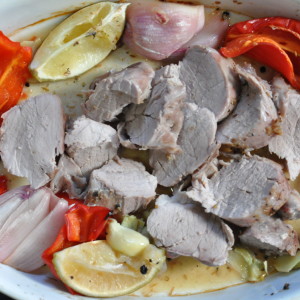White Beans
A year ago this month my husband John was admitted to the hospital, spending part of that time in the ICU. After three weeks, he was discharged with a diagnosis of diverticulosis and told to eat more fiber.

Longtime readers know John has a rare form of Muscular Dystrophy. He’s used a power wheelchair since 1998.
Being unable to walk impacts the entire body. Your feet swell from lack of movement. Your skin is at increasing risk of breakdown and sepsis, especially on your backside.
This same inability to stand wreaks havoc on the digestion. Our guts need movement to move.
—
The doctors treating John meant well, but “eat more fiber” was ridiculous advice. John adores fruit, especially berries. He’s also a big fan of salads. Meaning he was already consuming plenty of fiber–certainly more than the average person. And given his underlying medical condition, eating more fiber wasn’t likely to help.
Still, we had nothing to lose by trying. To that end, I added dried beans to our diet.

I’ve mentioned my difficulties preparing dried beans in an earlier post. Briefly, I’d tried cooking them on numerous occasions and met with resounding failure. Each time I blamed myself when the trouble lay with the beans, which were old. So old no amount of cooking would soften them.
My fear of bean cookery was exacerbated by the conflicting information surronding them. Like cassoulet, chicken broth, and Caesar Salad, bean cookery is wrapped in rules, lore, and heated argument. Think about it: nobody argues about the best way to prepare a peanut butter sandwich. There are no special pots expressly designed for making tomato soup.

Lentils, close relatives of the bean and staple food of countless people, lack discussion forums about which lentil is better or how best to cook them.

But beans? A person could spend a culinary lifetime focusing on nothing but beans. In fact, many people do, arguing about whether or not to soak them, for how long, what to do with the soaking water, when to salt them….

Ad infinitem.

I feel life is stressful enough without arguing over beans.

Do be sure to purchase fresh beans. I once thought dried goods lasted forever, and learned the hard way they do not. If you are unsure about the product in your local market, all the hullabaloo surronding Rancho Gordo beans is true. They aren’t paying me to say so. They don’t know I am writing this. Rancho Gordo beans are available online, and well worth your money.

A word about soaking. I soak my beans for 3-4 hours. As they are very fresh, this means cooking time is never more than 90 minutes. But bean cooking is impossible to quantify, as your beans will be different than mine.

White beans are highly versatile, a useful quality in the culinary world and out. You can add some meat, as I did (leftover ham, from Easter), or leave the dish as is, for a vegetarian meal.
White beans also make a nice side dish. While they pair well with chicken and beef, they truly find their calling alongside any kind of pork.

White beans freeze well, too, so consider making extra for a night when cooking feels impossible.
See the recipe notes, below, for additional ways to serve white beans.

White Beans
Yield: One cup dried beans yields about three cups cooked beans.
Prep time: This depends on the beans; I soaked mine for 4 hours. Cooking time was 90 minutes.
2-3 tablespoons olive oil
1-2 garlic cloves, peeled and smashed
1 small onion, minced
1 carrot, peeled and sliced into coins
1 stick celery, sliced into coins (optional, nice if you have it)
bay leaf
2 sprigs parsley
1 cup/220 grams White Beans
2 teaspoons salt
3 grinds peppermill
Optional seasonings:
scant teaspoon teaspoon dried oregano
scant teaspoon dried garlic powder
scant teaspoon dried onion powder
scant teaspoon dried sumac
a pinch of Aleppo pepper
4-24 hours ahead of time: rinse beans in a strainer, picking through them for any detritus.
Put beans in large bowl and cover with cool water. Beans will expand, so account for this. If your kitchen is warm, refrigerate the bowl.
To cook the beans:
Some people cook the beans with the soaking water; others, like me, strain the soaking water and start with fresh. The choice is yours.
If you are straining, strain beans in a fine strainer.
Pour olive oil in a lidded ceramic, enameled, or comparable pot. Turn heat to medium low.
Add garlic, onion, carrot, and celery and cook gently, stirring occasionally, for about five minutes. You want the vegetables to soften in the oil. If the pot looks a bit dry, add more oil. Don’t let the vegetables brown deeply; taking a little color is fine.
Once the vegetables have softened, tip in the beans. Stir to mix with vegetables and olive oil. Add the bay leaf and parsley sprigs.
Add enough water to cover the beans by about two inches.
Bring to a boil and skim scum as well as you can. Once the scum stops rising, partially cover the pot and turn the heat down to a gentle simmer.
I confess that keeping beans at a simmer rather than a galloping boil is a challenge. Even with a flame tamer, I find myself fiddling with the heat a fair amount. This may be my oven; I wish you better luck. Even with this fiddling, the beans do just fine.
Stir beans occasionally, testing for doneness after one hour. Once the beans have softened, it is safe to season them. Add salt and pepper, tasting for seasoning. Add the optional seasonings, or your preferred seasonings, tasting as you go.
Serve white beans as is, with green salad and bread, or see the notes for additional serving ideas.
White beans keep, refrigerated, in a lidded container, up to five days. Freeze up to three months.
Notes:
The Rancho Gordo website offers precise bean cooking instructions.
Other ways to serve white beans:
On a soft tortilla with lettuce, tomato, onion, avocado, sour cream, and hot sauce.
If you have equal amounts of leftover beans and meat stored in its cooking juices, chop or slice the meat into small pieces and add it to the beans. Tip the meat cooking juices into the beans. Reheat. Eat. I did this with the last bit of a pork chop and a recent batch of white beans, and let me tell you, it was heavenly.
Make a white bean stew using diced boneless chicken thighs, peeled cubed potatoes (waxy or not), carrots, onion, garlic, and celery. Season with salt, pepper, dried oregano, and a little onion powder. Add the chicken during the last 35 minutes of cooking. Make this stew vegetarian using mushrooms or firm tofu. Optional additions: fresh or frozen peas, diced summer squash, red peppers, scallions.
Add beans to rice or pasta with a shower of fresh herbs.





